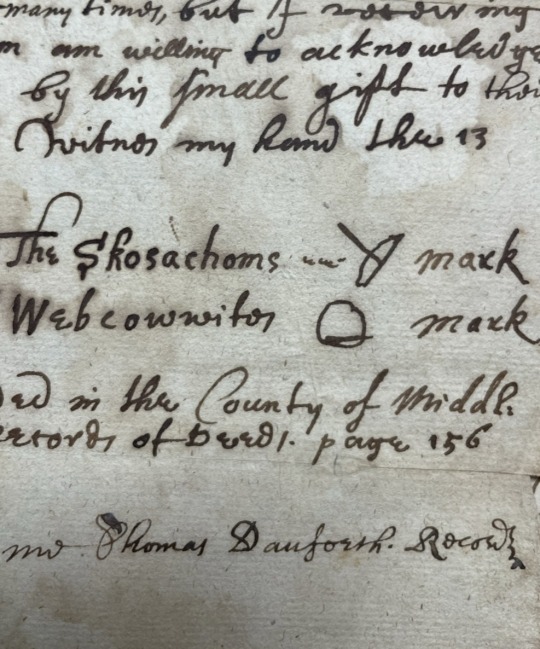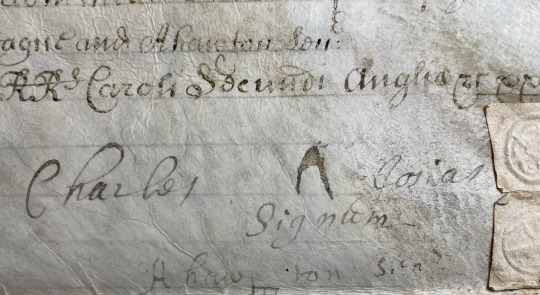#masshistoricalsociety
Text

James. His Mark.
Nipmuc, his homeplaces at Chaubunagungamaug and later perhaps at Quinnebaug (present day areas around and near Dudley and Webster, MA, and Thompson, CT, respectively). In this document, James is identified as the son and heir of “Black James Sachem of the Nipmug Country.”
Wullumahchein, or Black James, was a pawau or spiritual leader at Chaubunagungamag. Wullumachien was appointed “constable” to praying Indians by Daniel Gookin, signed a pledge not to fight against colonizers in King Philip’s war, and then fought against colonizers in King Philip’s war.
James’ kin: Father, Wullumahchein (aka Black James). Brother, Simon.
The original document was signed on December 27, 1686. The image here is from a later copy of the original, seen at the Massachusetts Historical Society.
#James#BlackJames#Wullumachien#nipmuc#chaubunagungamaug#websterma#dudleyma#thompsonct#connecticut#theirmarks#massachusetts#17thcentury#17c#masshistoricalsociety#algonquian#easternwoodlands#nativehistory
3 notes
·
View notes
Photo

My warm-up challenge this morning was to render another of my favorite landmarks back in my old state of Massachusetts. The challenge part was to do it as quickly as possible and with as few lines as possible. #masshistoricalsociety #whipplehouse #historicnewengland #ipswichma https://www.instagram.com/p/CCJG-3Gh6DO/?igshid=hsr55jlgrlpz
0 notes
Text


Webcowet. Webcowitt. Webcowwitos mark.
Massachusett. At home at the places that are today called Charlestown, Medford, Winchester, Massachusetts and surrounding areas. A pawau or spiritual leader, closely tied to the Sachem of Mistick after the death of her partner, Nanepashemet.
Photo 1: Land transfer marked in November 1636; the Sachem of Mistick references a tract of land “from Charlestown to Cambr[idge] which lays against the ponds at Mistick…”
Photo 2: The mark on this deed from April 15 1639. The deed describes land proximate to Charlestown, reserving lands along Mistick Pond for the Sachem of Mistick and her people to use for planting and hunting until her death.
Webcowitt’s Kin: Squaw Sachem of Mistick*
Seen at the Massachusetts Historical Society.
*In a previous post about the Sachem of Mistick we offered suggestions and information around the use of the term Squaw in the primary document and in subsequent references to the female sachem of Mistick. The term has been appropriated and the Algonquian word (and once honorific term) is now widely considered to be offensive and derogatory.
#webcowitt#mistick#massachusett#charlestown#cambridge#massachusetts#theirmarks#easternwoodlands#nativehistory#sachemofmistick#17thcentury#masshistoricalsociety#algonquian
1 note
·
View note
Text

Charles Josiah Wompatuck. Charles Josias. Signum.
Massachusett, with ties to Mattakeeset, Neponset and Wessagusset communities, in the areas south of the place today called “Boston, Massachusetts.” Sachem by 1671. Died after 1695. The mark seen here made on a deed for land from so-called Boston, south to present day Roxbury, Massachusetts, and included Deer Island.
Kin: his father, Josiah Wompatuck, Sachem at Mattakeesett. Grandfather, Chicatabut, Sachem at Wessagusset. Great-uncle, Cutshamequin, Sachem at Neponset.
Translated from the Algonquian, wompatuck means “white deer” in English.
This document is referred to as a quitclaim deed for the peninsula of Boston, Massachusetts. Signed March 19, 1684. Seen at the Massachusetts Historical Society.
#charlesjosiah#wompatuck#massachusett#mattakeeset#neponset#wessagusset#massachusetts#chicatabut#cutshamequin#theirmarks#hismark#17thcentury#17c#masshistoricalsociety#algonquian#easternwoodlands#nativehistory
0 notes
Text

Peter Ephraim. His Mark.
Natick Nipmuc. His home at Natick and the place today called “Sherborn, Massachusetts” and at Hassanamesit or so-called Grafton, Massachusetts. A “Christian Indian” and interpreter. Defended Nipmuc rights to land and petitioned against John Wampus’ fraudulent sale(s) of land at Hassanamesit through the 1670s. Died 1685.
This document outlines 2000 acres around the place now called Sherborn, MA, Peter Ephraim’s mark accompanying Waban’s, Piambow’s, John Magus’ and others.
Signed June 12, 1682. Seen at Massachusetts Historical Society.
#peterephraim#natick#nipmuc#hassanamesit#theirmarks#hismark#massachusetts#17thcentury#17c#masshistoricalsociety#algonquian#easternwoodlands#nativehistory
0 notes
Text


Lawrence Nassowanno. Their mark.
Nipmuc. His home in the places now called Brimfield, Monson, Palmer, Warren and Ware, Massachusetts. On this document, Lawrence Nassowanno identifies as “attorney to Anogomok, Sachem of the tract of land called Wombemesisecock.” The place of Wombemesisecock includes the areas today called “Palmer” and “Ware, Massachusetts.”
This deed signed on December 27, 1686. The image here is from a later copy of that original deed, seen at the Massachusetts Historical Society.
#17thcentury#theirmarks#algonquian#easternwoodlands#nativehistory#massachusetts#17c#nipmuc#lawrencenassowanno#wombemessisecock#masshistoricalsociety#Palmer#ware
0 notes
Text

**Content Warning: Racist/Misogynistic Slur**
Squaw Sachem. Squaw Sachem of Mistick. Saunkskwa of Missitekw. Skosachoms mark.
Her homelands spreading across the areas of present day Charlestown to Concord, MA. and across Massachusett, Nipmuc and Pawtucket territories. This land deed for a tract of land from so-called Charlestown and Cambridge, Massachusetts, “against the ponds at Misticke” to Jotham Gibbons. Marked on the 13th of November, 1636. Leader across several Massachusett and Pawtucket communities before, during and after the death of her first partner, Nanepashemet (d. 1619). She died in 1667.
Her Kin: Nanepashemet, a partner. Their sons, Wonohaquaham (or Sagamore John), Montowampate (or Sagamore James), and Wenepoykin (or Sagamore George). Wompachowet or Webcowit, a partner. Their daughter, Yawata (or Sarah).
This post offers an opportunity for reflection and discussion around the appropriation and derogatory meaning the Algonquian word (and once honorific term) “squaw” or “sonksqua” now holds. This document also calls to attention the lack of documentation of this leader’s Massachusett name. Despite her mark appearing on many ‘legal’ documents in the 17th century, her given name was never recorded. Perhaps Saunskskwa/Sonksqua was her chosen identity; perhaps colonizers weren’t concerned enough to record her other name(s).
Land deed, 13 November, 1636, recorded 1656. Seen @ Massachusetts Historical Society
#Massachusett#Sonksqua#Nanepashemet#Webcowit#hermark#theirmarks#17thcentury#17c#Massachusetts#algonquian#easternwoodlands#nativehistory#sachem#Cambridge#Charlestown#masshistoricalsociety
0 notes
Text

Anookamaug. Annogomok. Anogomok. Anogomog. His mark.
Nipmuc. Identified in this document as Sachem of Wombemesisecock, which we believe to be the places now called Palmer and Ware, Massachusetts. Wombemessisecock, near Quaboag, is bounded to the east by a pond, called Sasagookapaug, on the north and west by a river, Nenameseck, and to the north by a place called Wequaes. Place names are described in this deed and spelled here as in the document.
Anogamog appears as a signer to other deeds for land in this area, signing with the descendants of Piambow and other leaders from areas known to us as Menimeset, Winnimusset, and Quaboag.
This deed signed on December 27, 1686. Seen at the Massachusetts Historical Society.
#Annogomok#nipmuc#quaboag#wombemessisecock#theirmarks#hismark#massachusetts#17thcentury#17c#masshistoricalsociety#algonquian#easternwoodlands#nativehistory#piambow#winnemissett#anogomog
1 note
·
View note
Text

Piambo. Pyambow. Piamboho. Piambowhow. His Mark.
Nipmuc. His home at Hassanamesit (present day Grafton, MA and surrounding areas) and later at Natick. Interred on Deer Island during the First Indian War (King Philip's War). Leader in praying town at Natick, with Waban. Translator for John Eliot.
His mark appearing on deeds relative to land transfers and land disputes against settlers in Nipmuc country.
This deed, for land at a place today called Sherborn, Massachusetts, marked on June 20, 1682. Seen @ Massachusetts Historical Society.
#piambow#nipmuc#natick#hassanamesit#waban#theirmarks#hismark#massachusetts#17thcentury#17c#masshistoricalsociety#algonquian#deerisland#firstindianwar#easternwoodlands#nativehistory#kingphilipswar
0 notes